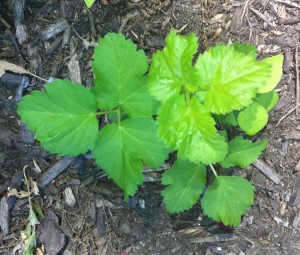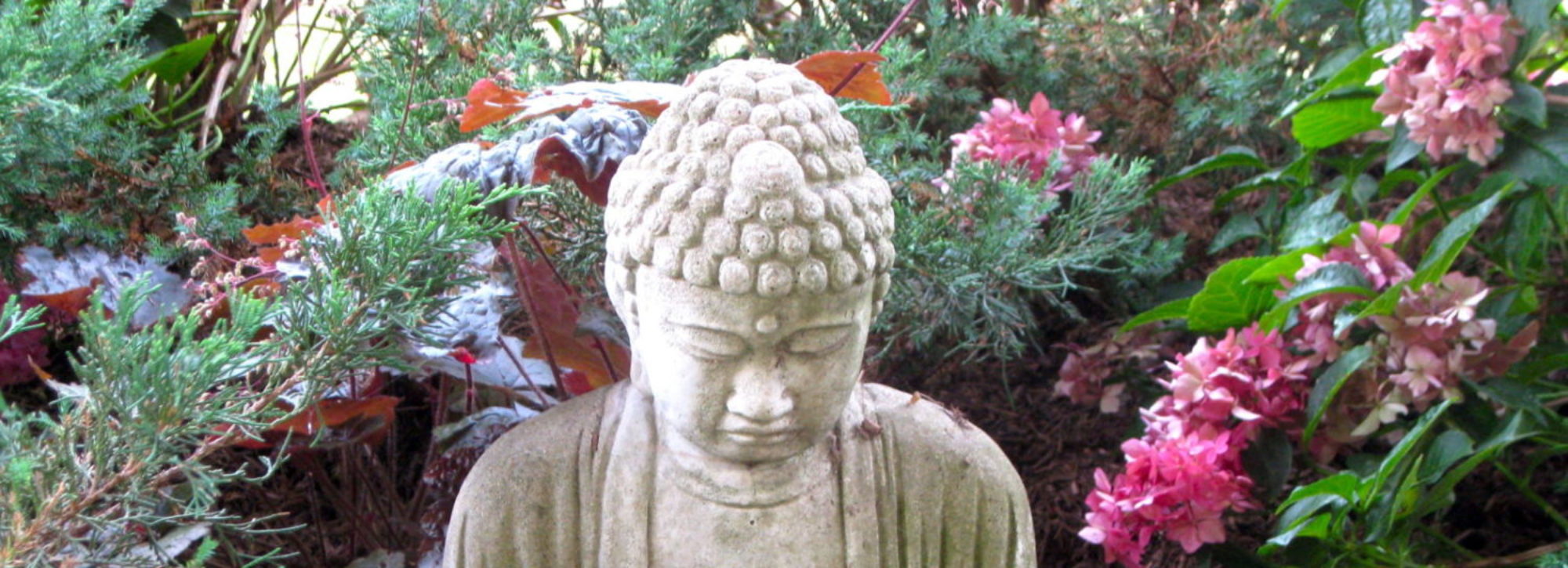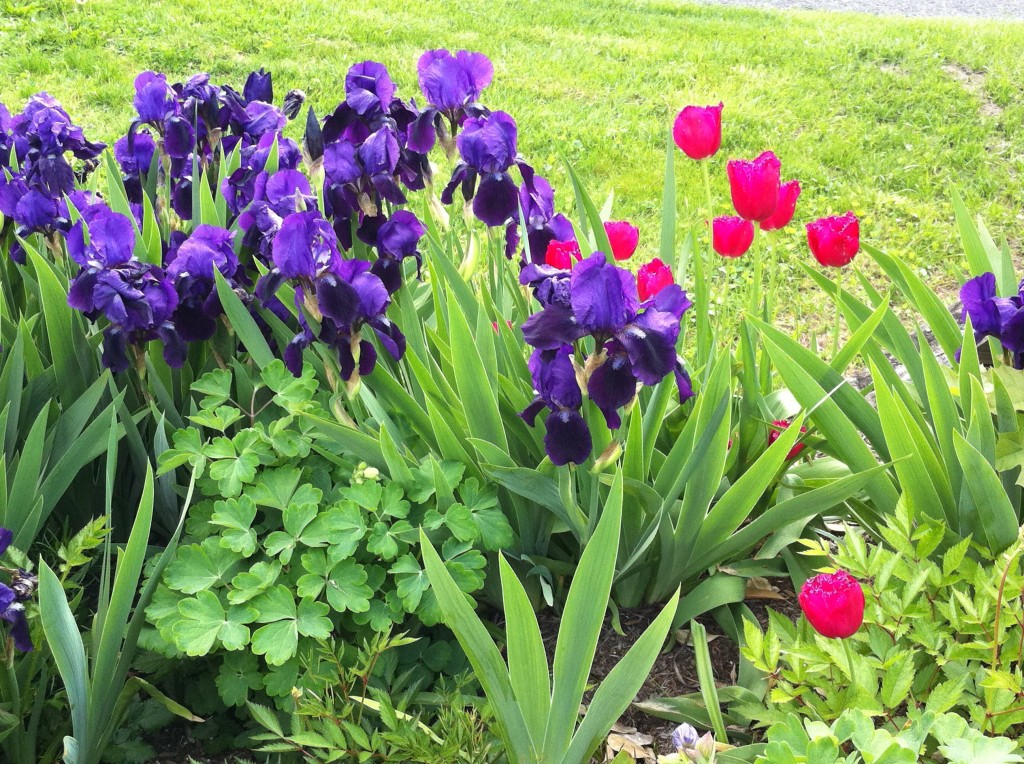Have I mentioned that we have a beautiful garden? Right now the irises, roses, poppies, clematis, and peonies are in full flower. The wisteria, lilac, daffodil and tulip blooms of the spring still linger in loving memory. Along with these beautiful flowers, our arch enemy, bishop’s weed, aegopodium podagraria (also known as gout weed, ground elder, goat’s foot, and Jack Jumpabout) has made its nefarious return. Bishop’s weed is a formidable foe. It defies almost every method of eradication, and the more countless hours my wife and I spend rooting it out, the more vigorously it returns.

The other night, in his teisho, Sensei Paul Seiko Schubert discussed how meditation was like gardening. It seemed a fitting metaphor. After all, the Pali word for meditation is bhavana, which literally means ”cultivation,” a word with clear horticultural roots. Professor Glen Wallis has written:
“I imagine that when Gotama, the Buddha, chose this word to talk about meditation, he had in mind the ubiquitous farms and fields of his native India. Unlike our words ‘meditation’ or ‘contemplation,’ Gotama’s term is musty, rich, and verdant. It smells of the earth. The commonness of his chosen term suggests naturalness, everydayness, ordinariness. The term also suggests hope: no matter how fallow it has become, or damaged it may be, a field can always be cultivated — endlessly enhanced, enriched, developed — to produce a favorable and nourishing harvest.”
Buddhism also employs another horticultural metaphor — the metaphor of ”seeds” (bija) to describe how past thoughts and actions lay down karmic traces in the unconscious which affect our future thoughts and actions.
But Sensei had a different horticultural metaphor in mind. He was pointing out that in gardening, no matter how hard one works at it, the weeds always return. Weeding is a constant practice, whether in gardening or meditation.
Of course there are many different kinds of mind-weeds — a practically infinite variety of desires, fears, concerns, and aversions in never-ending succession. Sensei had one particular sort in mind, however: one that relates specifically to Buddhist practice. These are the perennial questions of ”what next?” and ”what else?”
I had brought these very questions to Sensei in dokusan that evening. ”I’m wondering if I should be doing anything more with my practice?” I asked.
”What did you have in mind?” Sensei replied. I confessed I wasn’t sure, and Sensei responded with ”Just sit.” ”If there’s something else you need to do,” he added, ”it will emerge from your sitting — no one else can tell you what your practice needs.”
Sensei was pointing out that in both beginning and mature practice the same questions arise, but the answer is always the same: just return to awareness, sit quietly with the question, and allow what’s needed to emerge. In Zen there is no beginning practice and no advanced practice. There is just returning to awareness. Nothing is missing. Nothing needs to be added. There is no ”next” or ”else.”
I heard a charming gardening fable when I was interning at the Center for Mindfulness, Medicine, and Society in 1996. It’s one that’s made the rounds over the years in various forms. Marsha Linehan incorporated one version into her Dialectical Behavioral Therapy workbook for patients. The fable tells of a gardener who’s tried everything to rid his garden of weeds. In exasperation, he contacts a famous expert who inquires whether he’s attempted a variety of remedies. When the gardner replies he’s tried all of them, the expert pauses and reflects, and finally replies ”all I can suggest is that you learn to love the weeds.”
We shouldn’t be distressed or disturbed when mind weeds that we thought we uprooted long ago return once again. We should treat them like old friends. It’s not that we are doing our practice wrong. It’s just the nature of things. The weeds come back. We must be constant gardeners. The path of practice is unending. We return to it again and again.
Be diligent and light of heart.
Apologies to John le CarrÁ© for appropriating his title for this post!


Vuohenputki or Aegopodium podagraria is also well known here in Finland. It is a good example of the universality of human experience that is gradually revealed to diligent practitioners like us.
Did you know that besides being friends with Aegopodium, you can also eat them?
Aegopodium podagraria seems to be native to Europe and spread to US, while Lupinus polyphyllus is native to US and invasive here.
Vuohenputki! I now know a word in Finnish! Thanks!
I hear you can eat the leaves as you would spinach, and that the Romans introduced it as a food plant to the rest of Europe.
Seth, thank you for this interesting, informative and practically helpful article. However, I have a question about dealing with questions/issues on our minds which you discuss:
“Sensei was pointing out that in both beginning and mature practice the same questions arise, but the answer is always the same: just return to awareness, sit quietly with the question, and allow what’s needed to emerge.”
When you “sit quietly” do you bring the issue consciously to mind or just allow the sitting process to deal with it “subconsciously” (for want of a better word as a non-psychologist) i.e. in a similar way to how sometimes sleeping on a problem can resolve it?
By the way, this article is very timely because most of my time in the garden these days is spent weeding and I have only just been reading in “Zen Mind, Beginners Mind” two sections mentioning weeds (pages 119-121) and learning to value them:
“For Zen students a weed is a treasure”; Shunryu Suzuki
Warm wishes,
Terry
Terry, what good questions you ask!
The question is already there — you don’t really need to bring it to anything. It just exists as a question, sometimes as an explicit thought, sometimes as the background against which we sit. It doesn’t do any good to think about it. Usually when you think about it, just more thoughts arise, none of them particularly compelling. Almost always thoughts you’ve already had many times before. As Dogen says, “think not-thinking.” On the other hand, I’m very much attached to the process psychologist Eugene Gendlin has identified which he calls “focusing.” You can ask, “Does my practice need anything else?” and then just listen for some inward “felt sense.” That felt sense is often, at first, inchoate and fuzzy, but with gentle probing it can unfold into something clearer. Maybe that felt sense is “nothing is needed. Everything is already here.” Maybe that felt sense is the blossoming of something clear, urgent, and compelling. Something you’ve been avoiding or denying for some time. Gendlin doesn’t think that focusing and meditation have much in common, but that’s because Gendlin’s only thinking of samadhi practices when he thinks of meditation. I like to think of Gendlin’s “felt sense” as the “fifth foundation of mindfulness.”
It at least seems that branches of the tradion differ considerably on how active meditation should be, and that’s bothering me.
For example, Thanissaro Bikkhu talks about trying different ways to use the breath energy, finding what works best. And that one should find out where there is still stress and strain in the body or in the mental landscape, and work with that. Burmese noting technique tries to penetrate the object, and see three characteristics. Sayadaw U Tejaniya from Burma, on the other hand, is almost Zen-like. Even in Theravada there seems to be huge differences, from a very active approach to almost Zen-like simplicity with a bit of metta flavor.
I know that you like it simple, and you have earlier said “choose something and stick with it (for a few years).”. Well I have done that, kind of. 🙂 I’m just curious what you think of the variety of techniques, do they even lead to the same end result? One or several paths and awakenings? Defunct branches? What’s the common denominator?
Another great question! My best guess is that different techniques develop somewhat different qualities. The Bramhavihara meditations develop lovingkindness, compassion, sympathetic joy, and equanimity. The jhanas (depending on which one) develop unwavering attention, inner stillness, rapture, calm and non-attachment. Burmese noting develops awareness of impermanence, unsatisfactoriness, and non-self. Zazen develops mindfulness, inner calmness, and non-attachment. There’s probably considerable overlap in what qualities these techniques develop since they all have features in common (attention, observation, non-reactivity, etc.) — and also something unique about each one as well. These qualities, however, are all part of the Buddhist path. I doubt there’s one and only one practice that takes you — by itself — to Enlightenment. The best practice for any given individual probably depends on a variety of factors including one’s unique personality, cognitive and attentional abilities, belief system, needs, and level of development. That’s a lot of factors! That’s why I think that rather than believing there’s some all-knowing expert out there who can tell you what’s the right path for you, it’s better to try a few things out, find one that seems to click, and then cultivate it as long as it continues to be of benefit.
That last point is the tricky part — because there are stretches when any path can seem dry and unproductive, and doubt can develop about it — but that may be an inevitable part of the process that comes before a breakthrough to another level – – a “dark night of the soul.” When to stay with a method and when to switch to something that may be more productive is a tough call. If you find yourself hopping from one thing to another, you’re probably not doing yourself a favor. In the last resort, you always have to fall back on your own imperfect judgment, however — there’s nothing for it. But that judgment should be informed by what you are picking up from your readings, discussions with other sangha members, and talks with your teacher. There’s an endless ongoing dialog between your own experience and reason, the teachings as written, and the input from teachers and spiritual friends.
Lastly let me add that I once heard Tsoknyi Rinpoche say that meditation is like using computer applications within a windowing environment. “Too distractible, do a concentration meditation. Too dry, do a compassion meditation.” If you’ve gone too far to the left or right, there’s an app for that. One can combine techniques in a single sitting if one has developed a sophisticated rationale for how to do that. A Vajrayana sitting might begin, for example, by arousing bodhicitta, then proceed through guru and deity yoga, move on to dzogchen practice, and end with a dedication of merit. Insight meditation practice might begin with metta practice before proceeding on to mindfulness-of-the-breath, followed by a walking meditation.
In my own meditation, I move back and forth between what the Tibetan’s call “seven-point mind training” (which is a breath-concentration method akin to Theravada anapanasati) when I feel my concentration is weak, then when I feel my concentration has stabilized, I open up to choiceless awareness. This seems to work for me.
Sorry to be so long-winded.
Hello Seth,
this is so interesting, yes, different paths lead to different qualities and are for different people – and no one can tell which one is for me. But I am interested .. could you say more about how you combine Focusing with your practice? Is it a combination, an overlap, or is there anything that doesn’t fit? I practice Focusing myself and find the metaphor of gardening very helpful – it is loving, gentle, patient, caring; and one needs the right tools, too 🙂
Elmar — When I first read Gendlin’s description of direct referents I was impressed that he was describing an inner object of attention that had (to my knowledge) never been adequately described before. When I taught psychotherapy process to Yale psychology interns I always started by teaching both mindfulness and focusing. My experience was that novice psychologists had been well trained in cognitive behavioral therapy, but were largely ignorant of the inner world of sensation and experience and how important they were to the psychotherapeutic process. When I sit on the meditation cushion, I don’t do step-by-step focusing. But my experience with focusing has taught me when there is something there that is just on the edge of consciousness waiting to unfold. Sometimes, I think, just patient, bare attention is enough to allow it to blossom into awareness more fully. The whole verbal part of finding a label and checking it against the feeling can be left for later when one is off the cushion — the feeling can be noted and left to work on later.
Great metaphor !! I didn’t know the origin of that word. It made me look up some others:
meditation: (PIE) med= to measure/consider
bhÄvanÄ (Pali): cultivation
gom (Tibetan): to become familiar
Seth and everyone, I am very grateful for this discussion. More information on focusing would be of interest – a blog maybe?
Btw, I came across this earlier:
”The poor farmer makes weeds, the mediocre one makes crops, and the skilled farmer makes soil.”
— An old saying quoted by Kosho Uchiyama in “Opening the hand of thought” p. 168
Great Uchiyama quote! Thanks, Terry!